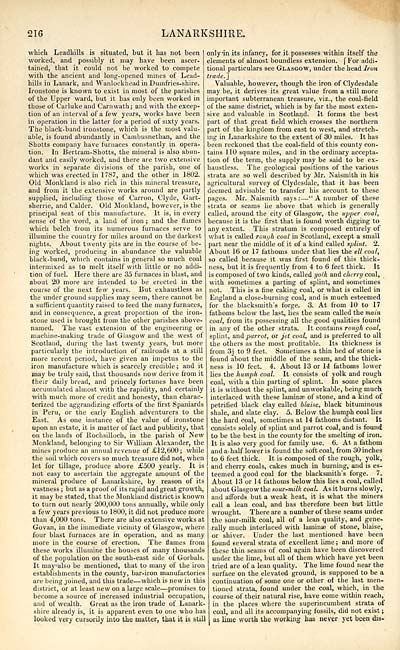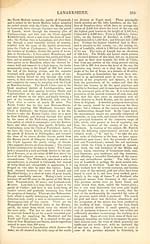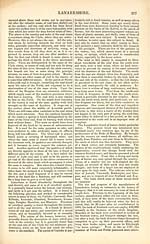Topographical, statistical, and historical gazetteer of Scotland > Volume 2
(228) Page 216
Download files
Complete book:
Individual page:
Thumbnail gallery: Grid view | List view

216
LANARKSHIRE.
which Leadhills is situated, but it has not been
worked, and possibly it may have been ascer-
tained, that it could not be worked to compete
with the ancient and long-opened mines of Lead-
hills in Lanark, and Wanlockhead in Dumfries-shire.
Ironstone is known to exist in most of the parishes
of the Upper ward, but it has only been worked in
those of Carluke and Carnwath; and with the excep-
tion of an interval of a few years, works have been
in operation in the latter for a period of sixty years.
The black-band ironstone, which is the most valu-
able, is found abundantly in Cambusnethan, and the
Shotts company have furnaces constantly in opera-
tion. In Bertram-Shotts, the mineral is also abun-
dant and easily worked, and there are two extensive
works in separate divisions of the parish, one of
which was erected in 1787, and the other in 1802.
Old Monkland is also rich in this mineral treasure,
and from it the extensive works around are partly
supplied, including those of Carron, Clyde, Gart-
sherrie, and Calder. Old Monkland, however, is the
principal seat of this manufacture. It is, in every
sense of the word, a land of iron ; and the flames
which belch from its numerous furnaces serve to
illumine the country for miles around on the darkest
nights. About twenty pits are in the course of be-
ing worked, producing in abundance the valuable
black-band, which contains in general so much coal
intermixed as to melt itself with little or no addi-
tion of fuel. Here there are 35 furnaces in blast, and
about 20 more are intended to be erected in the
course of the next few years. But exhaustless as
the under ground supplies may seem, there cannot be
a sufficient quantity raised to feed the many furnaces,
and in consequence, a great proportion of the iron-
stone used is brought from the other parishes above-
named. The vast, extension of the engineering or
machine-making trade of Glasgow and the west of
Scotland, during the last twenty years, but more
particularly the introduction of railroads at a still
more recent period, have given an impetus to the
iron manufacture which is scarcely credible ; and it
may be truly said, that thousands now derive from it
their daily bread, and princely fortunes have been
accumulated almost with the rapidity, and certainly
with much more of credit and honesty, than charac-
terized the aggrandizing efforts of the first Spaniards
in Peru, or the early English adventurers to the
East. As one instance of the value of ironstone
upon an estate, it is matter of fact and publicity, that
on the lands of Rochsilloch, in the parish of New
Monkland, belonging to Sir William Alexander, the
mines produce an annual revenue of £12,600; while
the soil which covers so much treasure did not, when
let for tillage, produce above £500 yearly. It is
not easy to ascertain the aggregate amount of the
mineral produce of Lanarkshire, by reason of its
vastness ; but as a proof of its rapid and great growth,
it may be stated, that the Monkland district is known
to turn out nearly 200,000 tons annually, while only
a few years previous to 1800, it did not produce more
than 4,000 tons. There are also extensive works at
Govan, in the immediate vicinity of Glasgow, where
four blast furnaces are in operation, and as many
more in the course of erection. The flames from
these works illumine the houses of many thousands
of the population on the south-east side of Goibals.
It may also be mentioned, that to many of the iron
establishments in the county, bar-iron manufactories
are being joined, and this trade — which is new in this
district, or at least new on a large scale — promises to
become a source of increased industrial occupation,
and of wealth. Great as the iron trade of Lanark-
shire already is, it is apparent even to one who has
looked very cursorily into the matter, that it is still
only -in its infancy, for it possesses within itself the
elements of almost boundless extension. ("For addi-
tional particulars see Glasgow, under the head Iron
traded]
Valuable, however, though the iron of Clydesdale
may be, it derives its great value from a still more
important subterranean treasure, viz., the coal-field
of the same district, which is by far the most exten-
sive and valuable in Scotland. It forms the best
part of that great field which crosses the northern
part of the kingdom from east to west, and stretch-
ing in Lanarkshire to the extent of 30 miles. It has
been reckoned that the coal-field of this county con-
tains 110 square miles, and in the ordinary accepta-
tion of the term, the supply may be said to be ex-
haustless. The geological positions of the various
strata are so well described by Mr. Naismith in his
agricultural survey of Clydesdale, that it has been
deemed advisable to transfer his account to these
pages. Mr. Naismith says : — ". A number of these
strata or seams lie above that which is generally
called, around the city of Glasgow, the upper coal,
because it is the first that is found worth digging to
any extent. This stratum is composed entirely of
what is called rough coal in Scotland, except a small
part near the middle of it of a kind called splint. 2.
About 16 or 17 fathoms under that lies the ell coal,
so called because it was first found of this thick-
ness, but it is frequently from 4 to 6 feet thick. It
is composed of two kinds, called yolk and cherry coal,
with sometimes a parting of splint, and sometimes
not. This is a fine caking coal, or what is called in
England a close-burning coal, and is much esteemed
for the blacksmith's forge. 3. At from 10 to 17
fathoms below the last, lies the seam called the main
coal, from its possessing all the good qualities found
in any of the other strata. It contains rough coal,
splint, and parrot, or jet coal, and is preferred to all
the others as the most profitable. Its thickness is
from 3i to 9 feet. Sometimes a thin bed of stone is
found about the middle of the seam, and the thick-
ness is 10 feet. 4. About 13 or 14 fathoms lower
lies the humph coal. It consists of yolk and rough
coal, with a thin parting of splint. In some places
it is without the splint, and unworkable, being much
interlaced with these laminae of stone, and a kind of
petrified black clay called blaise, black bituminous
shale, and slate clay. 5. Below the humph coal lies
the hard coal, sometimes at 14 fathoms distant. It
consists solely of splint and parrot coal, and is found
to be the best in the county for the smelting of iron.
It is also very good for family use. 6. At a fathom
and a- half lower is found the soft coal, from 30 inches
to 6 feet thick. It is composed of the rough, yolk,
and cherry coals, cakes much in burning, and is es-
teemed a good coal for the blacksmith's forge. 7.
About 13 or 14 fathoms below this lies a coal, called
about Glasgow the sour-milk coaL As it burns slowly,
and affords but a weak heat, it is what the miners
call a lean coal, and has therefore been but little
wrought. There are a number of these seams under
the sour-milk coal, all of a lean quality, and gene-
rally much interlaced with laminse of stone, blaise,
or shiver. Under the last mentioned have been
found several strata of excellent lime; and more of
these thin seams of coal again have been discovered
under the lime, but all of them which have yet been
tried are of a lean quality. The lime found near the
surface on the elevated ground, is supposed to be a
continuation of some one or other of the last men-
tioned strata, found under the coal, which, in the
course of their natural rise, have come within reach,
in the places where the superincumbent strata of
coal, and all its accompanying fossils, did not exist ;
as lime worth the working has never yet been (lis-
LANARKSHIRE.
which Leadhills is situated, but it has not been
worked, and possibly it may have been ascer-
tained, that it could not be worked to compete
with the ancient and long-opened mines of Lead-
hills in Lanark, and Wanlockhead in Dumfries-shire.
Ironstone is known to exist in most of the parishes
of the Upper ward, but it has only been worked in
those of Carluke and Carnwath; and with the excep-
tion of an interval of a few years, works have been
in operation in the latter for a period of sixty years.
The black-band ironstone, which is the most valu-
able, is found abundantly in Cambusnethan, and the
Shotts company have furnaces constantly in opera-
tion. In Bertram-Shotts, the mineral is also abun-
dant and easily worked, and there are two extensive
works in separate divisions of the parish, one of
which was erected in 1787, and the other in 1802.
Old Monkland is also rich in this mineral treasure,
and from it the extensive works around are partly
supplied, including those of Carron, Clyde, Gart-
sherrie, and Calder. Old Monkland, however, is the
principal seat of this manufacture. It is, in every
sense of the word, a land of iron ; and the flames
which belch from its numerous furnaces serve to
illumine the country for miles around on the darkest
nights. About twenty pits are in the course of be-
ing worked, producing in abundance the valuable
black-band, which contains in general so much coal
intermixed as to melt itself with little or no addi-
tion of fuel. Here there are 35 furnaces in blast, and
about 20 more are intended to be erected in the
course of the next few years. But exhaustless as
the under ground supplies may seem, there cannot be
a sufficient quantity raised to feed the many furnaces,
and in consequence, a great proportion of the iron-
stone used is brought from the other parishes above-
named. The vast, extension of the engineering or
machine-making trade of Glasgow and the west of
Scotland, during the last twenty years, but more
particularly the introduction of railroads at a still
more recent period, have given an impetus to the
iron manufacture which is scarcely credible ; and it
may be truly said, that thousands now derive from it
their daily bread, and princely fortunes have been
accumulated almost with the rapidity, and certainly
with much more of credit and honesty, than charac-
terized the aggrandizing efforts of the first Spaniards
in Peru, or the early English adventurers to the
East. As one instance of the value of ironstone
upon an estate, it is matter of fact and publicity, that
on the lands of Rochsilloch, in the parish of New
Monkland, belonging to Sir William Alexander, the
mines produce an annual revenue of £12,600; while
the soil which covers so much treasure did not, when
let for tillage, produce above £500 yearly. It is
not easy to ascertain the aggregate amount of the
mineral produce of Lanarkshire, by reason of its
vastness ; but as a proof of its rapid and great growth,
it may be stated, that the Monkland district is known
to turn out nearly 200,000 tons annually, while only
a few years previous to 1800, it did not produce more
than 4,000 tons. There are also extensive works at
Govan, in the immediate vicinity of Glasgow, where
four blast furnaces are in operation, and as many
more in the course of erection. The flames from
these works illumine the houses of many thousands
of the population on the south-east side of Goibals.
It may also be mentioned, that to many of the iron
establishments in the county, bar-iron manufactories
are being joined, and this trade — which is new in this
district, or at least new on a large scale — promises to
become a source of increased industrial occupation,
and of wealth. Great as the iron trade of Lanark-
shire already is, it is apparent even to one who has
looked very cursorily into the matter, that it is still
only -in its infancy, for it possesses within itself the
elements of almost boundless extension. ("For addi-
tional particulars see Glasgow, under the head Iron
traded]
Valuable, however, though the iron of Clydesdale
may be, it derives its great value from a still more
important subterranean treasure, viz., the coal-field
of the same district, which is by far the most exten-
sive and valuable in Scotland. It forms the best
part of that great field which crosses the northern
part of the kingdom from east to west, and stretch-
ing in Lanarkshire to the extent of 30 miles. It has
been reckoned that the coal-field of this county con-
tains 110 square miles, and in the ordinary accepta-
tion of the term, the supply may be said to be ex-
haustless. The geological positions of the various
strata are so well described by Mr. Naismith in his
agricultural survey of Clydesdale, that it has been
deemed advisable to transfer his account to these
pages. Mr. Naismith says : — ". A number of these
strata or seams lie above that which is generally
called, around the city of Glasgow, the upper coal,
because it is the first that is found worth digging to
any extent. This stratum is composed entirely of
what is called rough coal in Scotland, except a small
part near the middle of it of a kind called splint. 2.
About 16 or 17 fathoms under that lies the ell coal,
so called because it was first found of this thick-
ness, but it is frequently from 4 to 6 feet thick. It
is composed of two kinds, called yolk and cherry coal,
with sometimes a parting of splint, and sometimes
not. This is a fine caking coal, or what is called in
England a close-burning coal, and is much esteemed
for the blacksmith's forge. 3. At from 10 to 17
fathoms below the last, lies the seam called the main
coal, from its possessing all the good qualities found
in any of the other strata. It contains rough coal,
splint, and parrot, or jet coal, and is preferred to all
the others as the most profitable. Its thickness is
from 3i to 9 feet. Sometimes a thin bed of stone is
found about the middle of the seam, and the thick-
ness is 10 feet. 4. About 13 or 14 fathoms lower
lies the humph coal. It consists of yolk and rough
coal, with a thin parting of splint. In some places
it is without the splint, and unworkable, being much
interlaced with these laminae of stone, and a kind of
petrified black clay called blaise, black bituminous
shale, and slate clay. 5. Below the humph coal lies
the hard coal, sometimes at 14 fathoms distant. It
consists solely of splint and parrot coal, and is found
to be the best in the county for the smelting of iron.
It is also very good for family use. 6. At a fathom
and a- half lower is found the soft coal, from 30 inches
to 6 feet thick. It is composed of the rough, yolk,
and cherry coals, cakes much in burning, and is es-
teemed a good coal for the blacksmith's forge. 7.
About 13 or 14 fathoms below this lies a coal, called
about Glasgow the sour-milk coaL As it burns slowly,
and affords but a weak heat, it is what the miners
call a lean coal, and has therefore been but little
wrought. There are a number of these seams under
the sour-milk coal, all of a lean quality, and gene-
rally much interlaced with laminse of stone, blaise,
or shiver. Under the last mentioned have been
found several strata of excellent lime; and more of
these thin seams of coal again have been discovered
under the lime, but all of them which have yet been
tried are of a lean quality. The lime found near the
surface on the elevated ground, is supposed to be a
continuation of some one or other of the last men-
tioned strata, found under the coal, which, in the
course of their natural rise, have come within reach,
in the places where the superincumbent strata of
coal, and all its accompanying fossils, did not exist ;
as lime worth the working has never yet been (lis-
Set display mode to: Large image | Transcription
Images and transcriptions on this page, including medium image downloads, may be used under the Creative Commons Attribution 4.0 International Licence unless otherwise stated. ![]()
| Gazetteers of Scotland, 1803-1901 > Topographical, statistical, and historical gazetteer of Scotland > Volume 2 > (228) Page 216 |
|---|
| Permanent URL | https://digital.nls.uk/97451326 |
|---|
| Description | Volume second: I-Z. |
|---|---|
| Shelfmark | Map Room Ref.2 |
| Attribution and copyright: |
|

